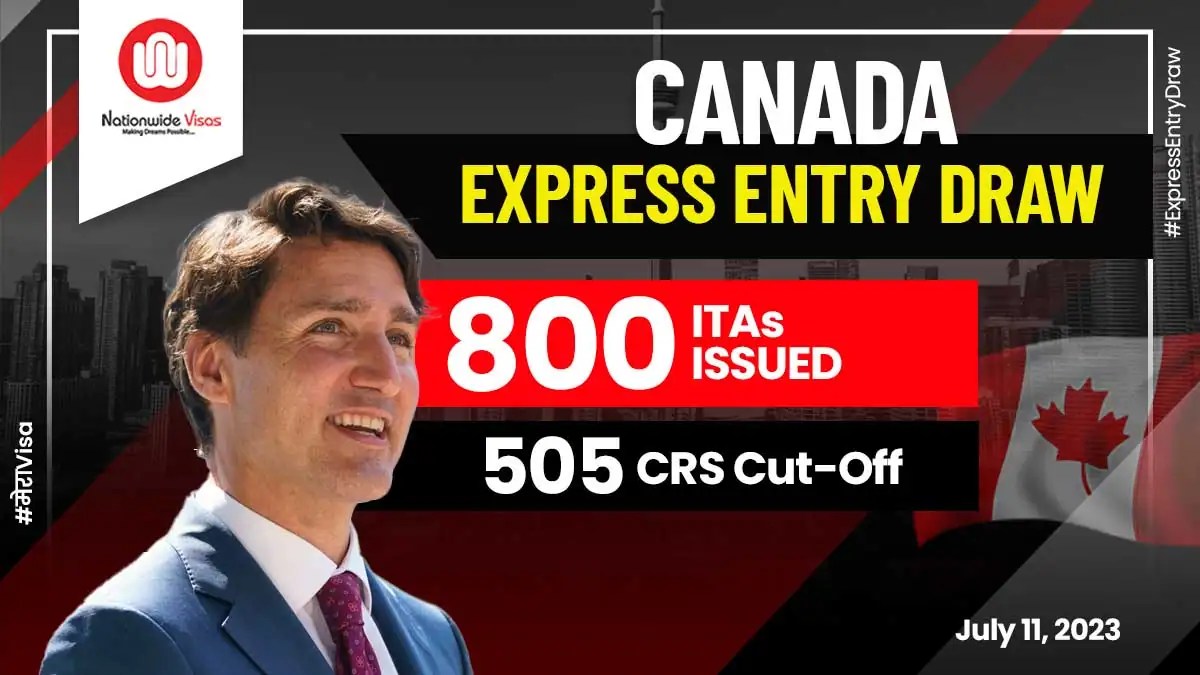IRCC Express Entry draws are your ticket to Canada! This system randomly selects candidates from a pool based on their Comprehensive Ranking System (CRS) score. Understanding the intricacies of the CRS, the factors influencing draws, and the application process is key to maximizing your chances of receiving an Invitation to Apply (ITA). This guide breaks down everything you need to know, from profile optimization to navigating the post-ITA procedures.
We’ll explore the mechanics of Express Entry, the criteria used for selection, and historical draw trends. We’ll also cover strategies to boost your CRS score, efficiently navigate the application, and handle potential challenges along the way. Get ready to learn how to increase your chances of immigrating to Canada!
Understanding IRCC Express Entry Draws
The Canadian Immigration, Refugees and Citizenship Canada (IRCC) utilizes the Express Entry system to manage applications for permanent residency. This system uses a points-based ranking system and regular draws to select candidates. Understanding the mechanics of this system is crucial for potential immigrants.
Express Entry System Mechanics and Draws
Express Entry operates through a pool of candidates who submit their profiles online. IRCC conducts regular draws, inviting the highest-ranking candidates to apply for permanent residency. The ranking is determined by the Comprehensive Ranking System (CRS).
IRCC Candidate Selection Criteria

IRCC selects candidates based on their Comprehensive Ranking System (CRS) score. This score considers factors like age, education, work experience, language proficiency, and arranged employment in Canada.
Comprehensive Ranking System (CRS) Breakdown
The CRS allocates points across several key areas: core human capital factors (age, education, language ability, and work experience), and additional factors (Canadian education, Canadian work experience, and a job offer).
| Year | Draw Date | Minimum CRS Score | Number of Invitations |
|---|---|---|---|
| 2023 | October 26, 2023 (Example) | 488 | 5,000 |
| 2023 | September 28, 2023 (Example) | 471 | 4,500 |
| 2023 | August 17, 2023 (Example) | 468 | 4,000 |
| 2023 | July 27, 2023 (Example) | 462 | 5,500 |
Note: These are example scores. Actual scores vary significantly depending on many factors. Always refer to the official IRCC website for the most up-to-date information.
Factors Influencing Draw Outcomes
Several factors influence the frequency, size, and minimum CRS scores of Express Entry draws. Understanding these factors is vital for prospective applicants to strategize their application.
So you’re prepping for the IRCC Express Entry draw? It’s a bit of a lottery, right? Think about how much faster things would be if we had a gravitic propulsion system to get your application across the world instantly! Okay, back to reality – focus on those CRS points and good luck with the draw!
Impact of Program Changes on Draw Outcomes
Changes in immigration policies, program priorities, or processing times can significantly impact draw outcomes. For example, increased focus on specific skilled occupations might lead to more targeted draws with higher minimum CRS scores.
Comparison of Express Entry Programs
Express Entry encompasses several immigration programs, each with its own requirements and selection criteria. The Federal Skilled Worker Program, Federal Skilled Trades Program, and Canadian Experience Class all contribute to the Express Entry pool, each influencing the overall draw dynamics.
Economic Factors and Labor Market Demands
Economic conditions and labor market demands heavily influence draw frequency and size. Periods of economic growth often see more frequent and larger draws, while economic downturns might lead to fewer invitations.
Future Trends in Express Entry Draws
Predicting future trends requires analyzing current immigration policies and economic forecasts. For example, continued emphasis on attracting skilled workers in high-demand occupations suggests that draws might focus on candidates with relevant skills and experience. However, it’s important to remember that these are predictions, and actual outcomes can vary significantly.
Candidate Profile Optimization for Express Entry
Maximizing your CRS score requires a strategic approach to building a strong candidate profile. This involves focusing on areas that yield the most points.
Sample High-Scoring Candidate Profile
A hypothetical high-scoring candidate might possess a PhD in a high-demand field, several years of relevant Canadian work experience, exceptional language proficiency (CLB 9 or higher in both English and French), and a job offer from a Canadian employer. This combination would significantly boost their CRS score.
Strategies for Improving Language Proficiency
Improving language skills is crucial. Dedicated study, immersion programs, and practice tests for IELTS or CELPIP are essential. Targeting specific weaknesses identified in practice tests is highly recommended.
Obtaining and Submitting Educational Credentials
Educational credentials must be evaluated by designated organizations to meet IRCC standards. This involves obtaining official transcripts and having them assessed for Canadian equivalency. The process typically involves sending transcripts directly to the designated assessment organization.
Work Experience Points for Higher CRS Score
Relevant work experience, particularly in high-demand occupations and in Canada, significantly contributes to the CRS score. Candidates should carefully document their work history, highlighting skills and responsibilities relevant to their chosen occupation.
- Management experience
- Technical expertise in high-demand fields
- Significant years of experience in a specific role
Navigating the Application Process
The Express Entry application process involves several key steps. Careful planning and attention to detail are crucial for a successful application.
Steps in Creating an Express Entry Profile
Creating a profile involves registering on the IRCC website, providing personal information, and completing the required forms. Accuracy is paramount as any inconsistencies can lead to delays or rejection.
Submitting Supporting Documents, Ircc express entry draw
Supporting documents, such as educational credentials, work experience proof, and language proficiency test results, must be uploaded to the online profile. These documents must be properly translated and certified if not in English or French.
Medical Examinations and Background Checks
Successful candidates will be instructed to undergo medical examinations and background checks. These are essential steps in the process to ensure eligibility for permanent residency.
Application Checklist
- Complete and accurate personal information
- Certified educational credentials
- Proof of work experience
- Language proficiency test results
- Any other required supporting documents
Post-Invitation to Apply (ITA) Procedures
Receiving an ITA is a significant step. Applicants must act promptly and accurately to complete the application process.
So, you’re checking the IRCC Express Entry draw results? It’s a pretty intense process, right? Completely unrelated, but did you hear about the news concerning OpenAI boss Sam Altman denying sexual abuse allegations made by a former employee? Anyway, back to the Express Entry draw – good luck with your application! Fingers crossed for that ITA.
Steps After Receiving an ITA
After receiving an ITA, applicants must complete the application form, submit additional documents, and pay the required fees within the stipulated timeframe. Missing the deadline can result in the withdrawal of the invitation.
Completing the Application Form
The application form requires detailed and accurate information. Applicants should carefully review all sections and ensure all information is consistent with previously submitted documents.
Submitting Biometric Information

Depending on the applicant’s location, they may be required to submit biometric information (fingerprints and photograph) at a designated collection center.
Preparing for the Visa Interview (if applicable)
While not always required, some applicants may be invited for a visa interview. Preparing for this interview involves reviewing the application details, practicing answers to common questions, and presenting a confident and organized demeanor.
Understanding IRCC Communication and Support
IRCC uses various channels to communicate with applicants. Understanding these channels and how to access support is essential for a smooth application process.
IRCC Communication Channels
IRCC communicates primarily through the online application portal, email, and occasionally by mail. Applicants should regularly check their online accounts for updates and messages.
Tracking Application Status
The online application portal allows applicants to track the status of their application, providing real-time updates on processing stages.
Common IRCC Communications and Responses
Applicants should respond promptly to any requests for additional information or clarification from IRCC. Ignoring communication can lead to delays or rejection.
Accessing IRCC Online Resources
IRCC’s website offers comprehensive information, guides, and FAQs related to the Express Entry system and the application process. Utilizing these resources is crucial for a well-informed application.
Potential Challenges and Solutions in the Express Entry Process
Applicants may encounter several challenges during the Express Entry process. Proactive planning and problem-solving strategies can mitigate these difficulties.
Common Challenges Faced by Applicants
Common challenges include incomplete documentation, delays in processing, and difficulties meeting specific requirements. Language barriers can also pose a significant challenge for some applicants.
Solutions for Overcoming Challenges
Addressing incomplete documentation requires careful review of requirements and timely submission of all necessary documents. Delays can sometimes be mitigated by proactively contacting IRCC and seeking clarification.
Handling Application Rejections and Appeals
Application rejections often occur due to incomplete information or failure to meet specific criteria. Applicants have the right to appeal decisions, but this requires a strong understanding of the reasons for rejection and a well-supported appeal.
Resources and Support for Applicants
Various resources are available to support applicants, including immigration consultants, legal professionals, and community organizations. These resources can provide guidance and assistance throughout the application process.
Closing Notes

Successfully navigating the IRCC Express Entry draw requires a well-structured approach and a thorough understanding of the system. By optimizing your profile, diligently preparing your application, and staying informed about draw trends and program changes, you significantly increase your chances of receiving an ITA. Remember to utilize IRCC’s resources and seek professional guidance when needed. Good luck on your journey to Canada!
So you’re keeping an eye on the IRCC Express Entry draw, hoping for that invite? It’s a bit of a lottery, right? Completely unrelated, but I just read about the fullerton plane crash – a sobering reminder of how unpredictable life can be. Anyway, back to the Express Entry draw – fingers crossed for all of us applicants!
General Inquiries: Ircc Express Entry Draw
What happens if my CRS score is low?
A lower CRS score means your chances of being selected in a draw are reduced. Focus on improving your score by enhancing your language skills, education, or work experience.
How long does the entire Express Entry process take?
The processing time varies, but it can range from several months to over a year, depending on various factors including your application’s completeness and the processing times at the IRCC.
Can I apply for Express Entry multiple times?
Yes, you can update your profile with any improvements to your CRS score. However, you only need one active profile at a time.
What if I make a mistake on my application?
Try to catch and correct errors before submitting. If you discover a mistake after submission, contact IRCC immediately to explain the situation and seek guidance on how to proceed.
